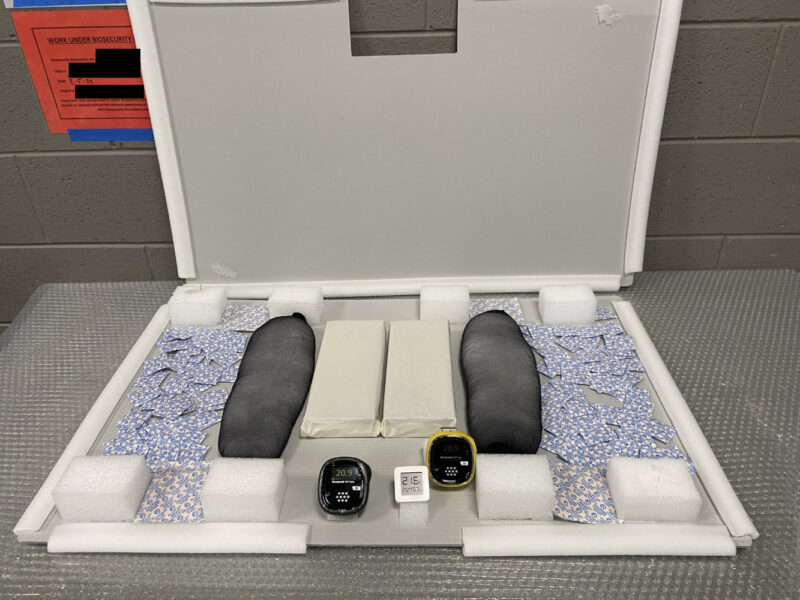In the past, the National Gallery of Victoria (NGV) has undertaken small-scale low-oxygen pest treatments utilising Ageless® (Mitsubishi Gas Chemicals) oxygen absorbers and using the Ageless® ‘eye’ to indicate when the required low level of oxygen was reached (the indicator turns pink when the oxygen levels are at 0.1% or less). However, when a pest treatment under direction from the Department of Agriculture, Water & Environment’s Biosecurity section was required to treat a pair of Japanese miniature folding screens (each approx. 30 x 9 x 7cm when closed), a more accountable method was required to demonstrate the success of the low-oxygen treatment.
In June 2020 the NGV purchased two oxygen gas detector loggers, Honeywell’s BW™ Solo devices, one to provide a backup system in case of the failure of our Mobigas® computerised system (by placing it inside the nitrogen-filled tent at the start of the treatment), and another to be used on the outside tent to allay any fears of a leak. While there are other gas detectors on the market, such as the Hanwell AnoxiBug system specifically designed for pest treatments for objects, they didn’t have the same flexibility of use as the BW Solo or have local suppliers or tech support.
While the BW Solo devices were sold to us as suitable for the above requirements, their use for low-oxygen treatments is vastly different to their intended use as described in the operating manual: that is, to provide a safety alert to people working in confined spaces with potential oxygen reduction in the air they breathe. This meant some problem-solving was required to change the settings for our requirements. While we had used the devices for a couple of low-risk treatments of potentially pest-affected artworks, those experiences had some problems with the battery running out (user error due to a wrong setting) or the Bluetooth connections not working (a software issue). So, further work was required to provide a more reliable data log.
With assistance from the supplier, Active Environmental Solutions, troubleshooting included finding ways to preserve battery life for the duration of the five-week treatment, turning off all visual/audible/vibration alarms, and setting parameters and options only available through the Bluetooth function. We now know how to set up the BW Solo for use within an airtight enclosure for a low-oxygen pest treatment and are able to provide CSV data to Biosecurity to verify the oxygen levels stayed at 0.3% or lower during the course of the five-week treatment. We can see visually or via the Bluetooth functionality the real-time oxygen level within the bag. Unlike other oxygen sensors, which require a puncture to the bag for the air to be drawn into the device, the BW Solo is enclosed within the gas-impermeable bag and left running throughout the course of the treatment. In addition, a Bluetooth-accessible mini data logger recording temperature and relative humidity was also enclosed within the air-tight package to monitor these parameters too.
Due to the small size of the overall package we were able to reach the set oxygen levels (0.3%) within 24hrs, and the sealed package maintained 0% oxygen for the duration of the five-week treatment. A CSV data set was able to be downloaded via the Honeywell Device Configurator app.
If anyone would like to access instructions on how to set up the Honeywell BW Solo for use within a low-oxygen pest treatment system, please get in touch and I can email it to you.
Indicative costs (excl. GST):
- Cryovac® gas-impermeable plastic sheeting (existing stock utilised).
- Ageless® ZPT-100MBC (500ml) sachets, bag of 100 ($15), supplied by Preservers.com.au (supply of larger volume sachets wasn’t possible at the time).
- Honeywell BW™ Solo gas detector (O2) BWS1-XL-Y (Bluetooth version), supplied by Active Environmental Solutions ($590). Lithium battery Type ER14335, 3.6V ($24), lasting at least five weeks in constant reading mode. The sensor requires changing every two years ($379 + $100 calibration). The Honeywell Device Configurator App is free to download and use to view live and past data, and email data.
- Oxygen 18% 103L gas tank ($246) and regulator ($160) for calibration of the sensor prior to each treatment, supplied by Active Environmental Solutions.
- Xiaomi Mi Temperature and Humidity Sensor ($25), Bluetooth, CR2032 battery operated, supplied by PC Byte (online).
Set-up costs: approx. $1020.
Ongoing costs: $50 per treatment (of similar size).
Maintenance costs: $479 new sensor required every two years.

Image showing the package set-up prior to sealing in air-impermeable Cryovac® plastic sheeting. The package contains the two folded miniature screens, sachets of Ageless® oxygen absorber on the two outer sides, and decanted Art-Sorb® in stockings to maintain relative humidity at around 55–60%. The two BW™ Solo devices are in the foreground, with the Xiaomi Mi temp. and RH monitor in the middle. Two BW Solo devices were used as a failsafe. Image: Suzi Shaw.